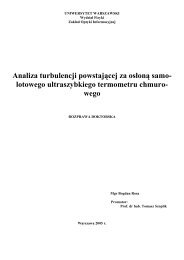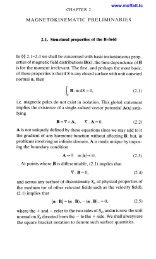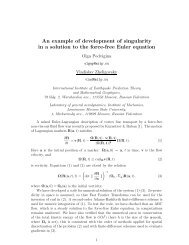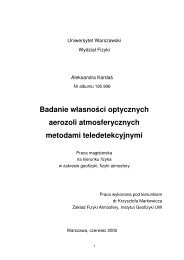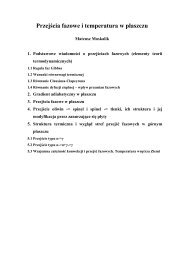slides, in English - Faculty of Physics
slides, in English - Faculty of Physics
slides, in English - Faculty of Physics
Create successful ePaper yourself
Turn your PDF publications into a flip-book with our unique Google optimized e-Paper software.
Aerosol process<strong>in</strong>g by drizzl<strong>in</strong>g stratocumulus:<br />
a modell<strong>in</strong>g study us<strong>in</strong>g a novel particle-based approach<br />
Sylwester Arabas<br />
Anna Jaruga<br />
Hanna Pawłowska<br />
University <strong>of</strong> Warsaw<br />
<strong>Faculty</strong> <strong>of</strong> <strong>Physics</strong><br />
Institute <strong>of</strong> Geophysics<br />
8 th International Conference on Cloud and Precipitation<br />
Leipzig, August 1 st 2012
aerosol process<strong>in</strong>g: concepts<br />
• <strong>in</strong>teractions: aerosol —⊲ cloud & precipitation —⊲ aerosol<br />
• processed CCN formed by evaporation <strong>of</strong><br />
• collisionally-grown drops<br />
• drops with<strong>in</strong> which irreversible oxidation occurred<br />
• CCN spectrum modification by wet deposition<br />
• adequate cloud µ-physics representations?
aerosol process<strong>in</strong>g: concepts<br />
• <strong>in</strong>teractions: aerosol —⊲ cloud & precipitation —⊲ aerosol<br />
• processed CCN formed by evaporation <strong>of</strong><br />
• collisionally-grown drops<br />
• drops with<strong>in</strong> which irreversible oxidation occurred<br />
• CCN spectrum modification by wet deposition<br />
• adequate cloud µ-physics representations?
aerosol process<strong>in</strong>g: concepts<br />
• <strong>in</strong>teractions: aerosol —⊲ cloud & precipitation —⊲ aerosol<br />
• processed CCN formed by evaporation <strong>of</strong><br />
• collisionally-grown drops<br />
• drops with<strong>in</strong> which irreversible oxidation occurred<br />
• CCN spectrum modification by wet deposition<br />
• adequate cloud µ-physics representations?
aerosol process<strong>in</strong>g: concepts<br />
• <strong>in</strong>teractions: aerosol —⊲ cloud & precipitation —⊲ aerosol<br />
• processed CCN formed by evaporation <strong>of</strong><br />
• collisionally-grown drops<br />
• drops with<strong>in</strong> which irreversible oxidation occurred<br />
• CCN spectrum modification by wet deposition<br />
• adequate cloud µ-physics representations?
aerosol process<strong>in</strong>g: concepts<br />
• <strong>in</strong>teractions: aerosol —⊲ cloud & precipitation —⊲ aerosol<br />
• processed CCN formed by evaporation <strong>of</strong><br />
• collisionally-grown drops<br />
• drops with<strong>in</strong> which irreversible oxidation occurred<br />
• CCN spectrum modification by wet deposition<br />
• adequate cloud µ-physics representations?
aerosol process<strong>in</strong>g: adequate µ-physics?<br />
key features <strong>of</strong> the Lagrangian (<strong>in</strong> size) approach:<br />
• diffusive error-free particle growth schemes<br />
(aka ”mov<strong>in</strong>g sectional”)<br />
• scales better than ND-b<strong>in</strong><br />
with grow<strong>in</strong>g number <strong>of</strong> particle attributes<br />
• . . .<br />
coupled with Lagrangian-<strong>in</strong>-space super-droplet approach
aerosol process<strong>in</strong>g: adequate µ-physics?<br />
s<strong>in</strong>gle-moment bulk:<br />
no <strong>in</strong>fluence <strong>of</strong> aerosol on cloud<br />
key features <strong>of</strong> the Lagrangian (<strong>in</strong> size) approach:<br />
• diffusive error-free particle growth schemes<br />
(aka ”mov<strong>in</strong>g sectional”)<br />
• scales better than ND-b<strong>in</strong><br />
with grow<strong>in</strong>g number <strong>of</strong> particle attributes<br />
• . . .<br />
coupled with Lagrangian-<strong>in</strong>-space super-droplet approach
aerosol process<strong>in</strong>g: adequate µ-physics?<br />
s<strong>in</strong>gle-moment bulk:<br />
no <strong>in</strong>fluence <strong>of</strong> aerosol on cloud<br />
multi-moment bulk,<br />
1D-b<strong>in</strong>:<br />
aerosol may <strong>in</strong>fluence cloud<br />
no "memory" <strong>of</strong> drop nuclei<br />
key features <strong>of</strong> the Lagrangian (<strong>in</strong> size) approach:<br />
• diffusive error-free particle growth schemes<br />
(aka ”mov<strong>in</strong>g sectional”)<br />
• scales better than ND-b<strong>in</strong><br />
with grow<strong>in</strong>g number <strong>of</strong> particle attributes<br />
• . . .<br />
coupled with Lagrangian-<strong>in</strong>-space super-droplet approach
aerosol process<strong>in</strong>g: adequate µ-physics?<br />
"dry radius" (nucleus)<br />
"wet radius" (solution drop)<br />
s<strong>in</strong>gle-moment bulk:<br />
no <strong>in</strong>fluence <strong>of</strong> aerosol on cloud<br />
multi-moment bulk,<br />
1D-b<strong>in</strong>:<br />
aerosol may <strong>in</strong>fluence cloud<br />
no "memory" <strong>of</strong> drop nuclei<br />
key features <strong>of</strong> the Lagrangian (<strong>in</strong> size) approach:<br />
• diffusive error-free particle growth schemes<br />
(aka ”mov<strong>in</strong>g sectional”)<br />
• scales better than ND-b<strong>in</strong><br />
with grow<strong>in</strong>g number <strong>of</strong> particle attributes<br />
• . . .<br />
coupled with Lagrangian-<strong>in</strong>-space super-droplet approach
aerosol process<strong>in</strong>g: adequate µ-physics?<br />
"dry radius" (nucleus)<br />
2D-b<strong>in</strong><br />
Eulerian<br />
"wet radius" (solution drop)<br />
s<strong>in</strong>gle-moment bulk:<br />
no <strong>in</strong>fluence <strong>of</strong> aerosol on cloud<br />
multi-moment bulk,<br />
1D-b<strong>in</strong>:<br />
aerosol may <strong>in</strong>fluence cloud<br />
no "memory" <strong>of</strong> drop nuclei<br />
key features <strong>of</strong> the Lagrangian (<strong>in</strong> size) approach:<br />
• diffusive error-free particle growth schemes<br />
(aka ”mov<strong>in</strong>g sectional”)<br />
• scales better than ND-b<strong>in</strong><br />
with grow<strong>in</strong>g number <strong>of</strong> particle attributes<br />
• . . .<br />
coupled with Lagrangian-<strong>in</strong>-space super-droplet approach
aerosol process<strong>in</strong>g: adequate µ-physics?<br />
"dry radius" (nucleus)<br />
2D-b<strong>in</strong><br />
Eulerian<br />
Lagrangian<br />
"wet radius" (solution drop)<br />
s<strong>in</strong>gle-moment bulk:<br />
no <strong>in</strong>fluence <strong>of</strong> aerosol on cloud<br />
multi-moment bulk,<br />
1D-b<strong>in</strong>:<br />
aerosol may <strong>in</strong>fluence cloud<br />
no "memory" <strong>of</strong> drop nuclei<br />
key features <strong>of</strong> the Lagrangian (<strong>in</strong> size) approach:<br />
• diffusive error-free particle growth schemes<br />
(aka ”mov<strong>in</strong>g sectional”)<br />
• scales better than ND-b<strong>in</strong><br />
with grow<strong>in</strong>g number <strong>of</strong> particle attributes<br />
• . . .<br />
coupled with Lagrangian-<strong>in</strong>-space super-droplet approach
aerosol process<strong>in</strong>g: adequate µ-physics?<br />
"dry radius" (nucleus)<br />
2D-b<strong>in</strong><br />
Eulerian<br />
Lagrangian<br />
"wet radius" (solution drop)<br />
s<strong>in</strong>gle-moment bulk:<br />
no <strong>in</strong>fluence <strong>of</strong> aerosol on cloud<br />
multi-moment bulk,<br />
1D-b<strong>in</strong>:<br />
aerosol may <strong>in</strong>fluence cloud<br />
no "memory" <strong>of</strong> drop nuclei<br />
key features <strong>of</strong> the Lagrangian (<strong>in</strong> size) approach:<br />
• diffusive error-free particle growth schemes<br />
(aka ”mov<strong>in</strong>g sectional”)<br />
• scales better than ND-b<strong>in</strong><br />
with grow<strong>in</strong>g number <strong>of</strong> particle attributes<br />
• . . .<br />
coupled with Lagrangian-<strong>in</strong>-space super-droplet approach
aerosol process<strong>in</strong>g: adequate µ-physics?<br />
"dry radius" (nucleus)<br />
2D-b<strong>in</strong><br />
Eulerian<br />
Lagrangian<br />
"wet radius" (solution drop)<br />
s<strong>in</strong>gle-moment bulk:<br />
no <strong>in</strong>fluence <strong>of</strong> aerosol on cloud<br />
multi-moment bulk,<br />
1D-b<strong>in</strong>:<br />
aerosol may <strong>in</strong>fluence cloud<br />
no "memory" <strong>of</strong> drop nuclei<br />
key features <strong>of</strong> the Lagrangian (<strong>in</strong> size) approach:<br />
• diffusive error-free particle growth schemes<br />
(aka ”mov<strong>in</strong>g sectional”)<br />
• scales better than ND-b<strong>in</strong><br />
with grow<strong>in</strong>g number <strong>of</strong> particle attributes<br />
• . . .<br />
coupled with Lagrangian-<strong>in</strong>-space super-droplet approach
Lagrangian µ-physics: key elements<br />
• each particle (aka super-droplet) many ”similar” real-world particles<br />
• attributes: multiplicity, dry radius, wet radius, nucleus type, . . .<br />
• aerosol, cloud, precip. particles not dist<strong>in</strong>guished, subject to same processes<br />
Eulerian / PDE<br />
advection <strong>of</strong> heat<br />
advection <strong>of</strong> moisture<br />
Lagrangian / ODE<br />
particle transport by the flow<br />
condensational growth<br />
collisional growth<br />
sedimentation<br />
∑<br />
∂ t (ρ d r) + ∇(⃗vρ d r) = ρ d ṙ ṙ =<br />
. . .<br />
particles ∈ ∆V<br />
∑<br />
∂ t (ρ d θ) + ∇(⃗vρ d θ) = ρ d ˙θ ˙θ = . . .<br />
particles ∈ ∆V<br />
advection <strong>of</strong> trace gases<br />
<strong>in</strong>-particle aqueous chemistry<br />
. . . . . .<br />
• recent examples <strong>in</strong> context <strong>of</strong> precipitat<strong>in</strong>g clouds:<br />
• Shima et al. 2009, QJ<br />
• Andrejczuk et al. 2010, JGR<br />
• Riechelmann et al. 2012, NJP
Lagrangian µ-physics: key elements<br />
• each particle (aka super-droplet) many ”similar” real-world particles<br />
• attributes: multiplicity, dry radius, wet radius, nucleus type, . . .<br />
• aerosol, cloud, precip. particles not dist<strong>in</strong>guished, subject to same processes<br />
Eulerian / PDE<br />
advection <strong>of</strong> heat<br />
advection <strong>of</strong> moisture<br />
Lagrangian / ODE<br />
particle transport by the flow<br />
condensational growth<br />
collisional growth<br />
sedimentation<br />
∑<br />
∂ t (ρ d r) + ∇(⃗vρ d r) = ρ d ṙ ṙ =<br />
. . .<br />
particles ∈ ∆V<br />
∑<br />
∂ t (ρ d θ) + ∇(⃗vρ d θ) = ρ d ˙θ ˙θ = . . .<br />
particles ∈ ∆V<br />
advection <strong>of</strong> trace gases<br />
<strong>in</strong>-particle aqueous chemistry<br />
. . . . . .<br />
• recent examples <strong>in</strong> context <strong>of</strong> precipitat<strong>in</strong>g clouds:<br />
• Shima et al. 2009, QJ<br />
• Andrejczuk et al. 2010, JGR<br />
• Riechelmann et al. 2012, NJP
Lagrangian µ-physics: key elements<br />
• each particle (aka super-droplet) many ”similar” real-world particles<br />
• attributes: multiplicity, dry radius, wet radius, nucleus type, . . .<br />
• aerosol, cloud, precip. particles not dist<strong>in</strong>guished, subject to same processes<br />
Eulerian / PDE<br />
advection <strong>of</strong> heat<br />
advection <strong>of</strong> moisture<br />
Lagrangian / ODE<br />
particle transport by the flow<br />
condensational growth<br />
collisional growth<br />
sedimentation<br />
∑<br />
∂ t (ρ d r) + ∇(⃗vρ d r) = ρ d ṙ ṙ =<br />
. . .<br />
particles ∈ ∆V<br />
∑<br />
∂ t (ρ d θ) + ∇(⃗vρ d θ) = ρ d ˙θ ˙θ = . . .<br />
particles ∈ ∆V<br />
advection <strong>of</strong> trace gases<br />
<strong>in</strong>-particle aqueous chemistry<br />
. . . . . .<br />
• recent examples <strong>in</strong> context <strong>of</strong> precipitat<strong>in</strong>g clouds:<br />
• Shima et al. 2009, QJ<br />
• Andrejczuk et al. 2010, JGR<br />
• Riechelmann et al. 2012, NJP
Lagrangian µ-physics: key elements<br />
• each particle (aka super-droplet) many ”similar” real-world particles<br />
• attributes: multiplicity, dry radius, wet radius, nucleus type, . . .<br />
• aerosol, cloud, precip. particles not dist<strong>in</strong>guished, subject to same processes<br />
Eulerian / PDE<br />
advection <strong>of</strong> heat<br />
advection <strong>of</strong> moisture<br />
Lagrangian / ODE<br />
particle transport by the flow<br />
condensational growth<br />
collisional growth<br />
sedimentation<br />
∑<br />
∂ t (ρ d r) + ∇(⃗vρ d r) = ρ d ṙ ṙ =<br />
. . .<br />
particles ∈ ∆V<br />
∑<br />
∂ t (ρ d θ) + ∇(⃗vρ d θ) = ρ d ˙θ ˙θ = . . .<br />
particles ∈ ∆V<br />
advection <strong>of</strong> trace gases<br />
<strong>in</strong>-particle aqueous chemistry<br />
. . . . . .<br />
• recent examples <strong>in</strong> context <strong>of</strong> precipitat<strong>in</strong>g clouds:<br />
• Shima et al. 2009, QJ<br />
• Andrejczuk et al. 2010, JGR<br />
• Riechelmann et al. 2012, NJP
Lagrangian µ-physics: key elements<br />
• each particle (aka super-droplet) many ”similar” real-world particles<br />
• attributes: multiplicity, dry radius, wet radius, nucleus type, . . .<br />
• aerosol, cloud, precip. particles not dist<strong>in</strong>guished, subject to same processes<br />
Eulerian / PDE<br />
advection <strong>of</strong> heat<br />
advection <strong>of</strong> moisture<br />
Lagrangian / ODE<br />
particle transport by the flow<br />
condensational growth<br />
collisional growth<br />
sedimentation<br />
∑<br />
∂ t (ρ d r) + ∇(⃗vρ d r) = ρ d ṙ ṙ =<br />
. . .<br />
particles ∈ ∆V<br />
∑<br />
∂ t (ρ d θ) + ∇(⃗vρ d θ) = ρ d ˙θ ˙θ = . . .<br />
particles ∈ ∆V<br />
advection <strong>of</strong> trace gases<br />
<strong>in</strong>-particle aqueous chemistry<br />
. . . . . .<br />
• recent examples <strong>in</strong> context <strong>of</strong> precipitat<strong>in</strong>g clouds:<br />
• Shima et al. 2009, QJ<br />
• Andrejczuk et al. 2010, JGR<br />
• Riechelmann et al. 2012, NJP
Lagrangian µ-physics: key elements<br />
• each particle (aka super-droplet) many ”similar” real-world particles<br />
• attributes: multiplicity, dry radius, wet radius, nucleus type, . . .<br />
• aerosol, cloud, precip. particles not dist<strong>in</strong>guished, subject to same processes<br />
Eulerian / PDE<br />
advection <strong>of</strong> heat<br />
advection <strong>of</strong> moisture<br />
Lagrangian / ODE<br />
particle transport by the flow<br />
condensational growth<br />
collisional growth<br />
sedimentation<br />
∑<br />
∂ t (ρ d r) + ∇(⃗vρ d r) = ρ d ṙ ṙ =<br />
. . .<br />
particles ∈ ∆V<br />
∑<br />
∂ t (ρ d θ) + ∇(⃗vρ d θ) = ρ d ˙θ ˙θ = . . .<br />
particles ∈ ∆V<br />
advection <strong>of</strong> trace gases<br />
<strong>in</strong>-particle aqueous chemistry<br />
. . . . . .<br />
• recent examples <strong>in</strong> context <strong>of</strong> precipitat<strong>in</strong>g clouds:<br />
• Shima et al. 2009, QJ<br />
• Andrejczuk et al. 2010, JGR<br />
• Riechelmann et al. 2012, NJP
Lagrangian µ-physics: key elements<br />
• each particle (aka super-droplet) many ”similar” real-world particles<br />
• attributes: multiplicity, dry radius, wet radius, nucleus type, . . .<br />
• aerosol, cloud, precip. particles not dist<strong>in</strong>guished, subject to same processes<br />
Eulerian / PDE<br />
advection <strong>of</strong> heat<br />
advection <strong>of</strong> moisture<br />
Lagrangian / ODE<br />
particle transport by the flow<br />
condensational growth<br />
collisional growth<br />
sedimentation<br />
∑<br />
∂ t (ρ d r) + ∇(⃗vρ d r) = ρ d ṙ ṙ =<br />
. . .<br />
particles ∈ ∆V<br />
∑<br />
∂ t (ρ d θ) + ∇(⃗vρ d θ) = ρ d ˙θ ˙θ = . . .<br />
particles ∈ ∆V<br />
advection <strong>of</strong> trace gases<br />
<strong>in</strong>-particle aqueous chemistry<br />
. . . . . .<br />
• recent examples <strong>in</strong> context <strong>of</strong> precipitat<strong>in</strong>g clouds:<br />
• Shima et al. 2009, QJ<br />
• Andrejczuk et al. 2010, JGR<br />
• Riechelmann et al. 2012, NJP
Int. Cloud Modell<strong>in</strong>g Workshop 2012 ”drizzl<strong>in</strong>g Sc case”<br />
(Wojciech Grabowski & Zach Lebo)<br />
• VOCALS-<strong>in</strong>spired<br />
• 2D prescribed-flow (s<strong>in</strong>gle eddy)<br />
• bi-modal <strong>in</strong>itial dry aerosol spectrum<br />
• details:<br />
http://rap.ucar.edu/˜ gthompsn/workshop2012/case1/
Int. Cloud Modell<strong>in</strong>g Workshop 2012 ”drizzl<strong>in</strong>g Sc case”<br />
(Wojciech Grabowski & Zach Lebo)<br />
• VOCALS-<strong>in</strong>spired<br />
• 2D prescribed-flow (s<strong>in</strong>gle eddy)<br />
• bi-modal <strong>in</strong>itial dry aerosol spectrum<br />
• details:<br />
http://rap.ucar.edu/˜ gthompsn/workshop2012/case1/
Int. Cloud Modell<strong>in</strong>g Workshop 2012 ”drizzl<strong>in</strong>g Sc case”<br />
(Wojciech Grabowski & Zach Lebo)<br />
• VOCALS-<strong>in</strong>spired<br />
• 2D prescribed-flow (s<strong>in</strong>gle eddy)<br />
• bi-modal <strong>in</strong>itial dry aerosol spectrum<br />
• details:<br />
http://rap.ucar.edu/˜ gthompsn/workshop2012/case1/<br />
super-droplet conc. [1/dx/dy/dz]<br />
cloud droplet conc. [1/cm 3 ]<br />
aerosol concentration [1/cm 3 ]<br />
1.4<br />
140<br />
1.4<br />
140<br />
1.4<br />
140<br />
1.2<br />
120<br />
1.2<br />
120<br />
1.2<br />
120<br />
1<br />
100<br />
1<br />
100<br />
1<br />
100<br />
Y [km]<br />
0.8<br />
0.6<br />
80<br />
60<br />
Y [km]<br />
0.8<br />
0.6<br />
80<br />
60<br />
Y [km]<br />
0.8<br />
0.6<br />
80<br />
60<br />
0.4<br />
40<br />
0.4<br />
40<br />
0.4<br />
40<br />
0.2<br />
20<br />
0.2<br />
20<br />
0.2<br />
20<br />
0<br />
0 0.2 0.4 0.6 0.8 1 1.2 1.4<br />
X [km]<br />
0<br />
0<br />
0 0.2 0.4 0.6 0.8 1 1.2 1.4<br />
X [km]<br />
0<br />
0<br />
0 0.2 0.4 0.6 0.8 1 1.2 1.4<br />
X [km]<br />
0
icicle<br />
http://icicle.igf.fuw.edu.pl/<br />
• icicle – a new open-source advection eq. systems solver<br />
• Eulerian advection: MPDATA (Smolarkiewicz 1983, . . . )<br />
• . . .<br />
• icicle’s Lagrangian µ-physics module:<br />
• coalescence: Super-Droplet Monte-Carlo Scheme (Shima et al. 2009)<br />
• aerosol hygroscopicity: κ-Köhler (Petters & Kreidenweis, 2007)<br />
• gravitational sedimentation: Khvorostyanov & Curry, 2002<br />
• . . .<br />
• implementation: C++ / Thrust (GPU-ready!)
icicle<br />
http://icicle.igf.fuw.edu.pl/<br />
• icicle – a new open-source advection eq. systems solver<br />
• Eulerian advection: MPDATA (Smolarkiewicz 1983, . . . )<br />
• . . .<br />
• icicle’s Lagrangian µ-physics module:<br />
• coalescence: Super-Droplet Monte-Carlo Scheme (Shima et al. 2009)<br />
• aerosol hygroscopicity: κ-Köhler (Petters & Kreidenweis, 2007)<br />
• gravitational sedimentation: Khvorostyanov & Curry, 2002<br />
• . . .<br />
• implementation: C++ / Thrust (GPU-ready!)
icicle<br />
http://icicle.igf.fuw.edu.pl/<br />
• icicle – a new open-source advection eq. systems solver<br />
• Eulerian advection: MPDATA (Smolarkiewicz 1983, . . . )<br />
• . . .<br />
• icicle’s Lagrangian µ-physics module:<br />
• coalescence: Super-Droplet Monte-Carlo Scheme (Shima et al. 2009)<br />
• aerosol hygroscopicity: κ-Köhler (Petters & Kreidenweis, 2007)<br />
• gravitational sedimentation: Khvorostyanov & Curry, 2002<br />
• . . .<br />
• implementation: C++ / Thrust (GPU-ready!)
Monte-Carlo coalescence scheme (Shima et al. 2009)<br />
• for all n super-droplets <strong>in</strong> a grid box <strong>of</strong> volume ∆V <strong>in</strong> timestep ∆t<br />
• each represent<strong>in</strong>g ξ real particles (aerosol/cloud/drizzle/ra<strong>in</strong>)<br />
• the probability <strong>of</strong> coalescence <strong>of</strong> i-th and j-th super-droplets is:<br />
P ij = max(ξ i , ξ j ) · E(r i , r j ) · π(r i + r j ) 2 · |v i − v j | · ∆t<br />
} {{ } ∆V · n·(n−1)<br />
2<br />
/ [ ]<br />
n<br />
2<br />
coalescence kernel<br />
where r – drop radii, E(r i , r j ) – collection efficiency, v – drop velocities<br />
• coalescence takes place once <strong>in</strong> a number <strong>of</strong> timesteps (def. by P ij )<br />
• all m<strong>in</strong>(ξ i ,ξ j ) droplets coalesce<br />
there’s always a ”b<strong>in</strong>” <strong>of</strong> the right size to store the collided particles<br />
• collisions triggered by compar<strong>in</strong>g a uniform random number with P ij<br />
• extensive parameters summed ( conserved), <strong>in</strong>tensive averaged<br />
• [n/2] random non-overlapp<strong>in</strong>g (i,j) pairs exam<strong>in</strong>ed <strong>in</strong>stead <strong>of</strong> all (i,j) pairs<br />
cost: O ( n 2) O ( n ) , probability upscaled by n·(n−1)<br />
2<br />
/ [ ]<br />
n<br />
2
Monte-Carlo coalescence scheme (Shima et al. 2009)<br />
• for all n super-droplets <strong>in</strong> a grid box <strong>of</strong> volume ∆V <strong>in</strong> timestep ∆t<br />
• each represent<strong>in</strong>g ξ real particles (aerosol/cloud/drizzle/ra<strong>in</strong>)<br />
• the probability <strong>of</strong> coalescence <strong>of</strong> i-th and j-th super-droplets is:<br />
P ij = max(ξ i , ξ j ) · E(r i , r j ) · π(r i + r j ) 2 · |v i − v j | · ∆t<br />
} {{ } ∆V · n·(n−1)<br />
2<br />
/ [ ]<br />
n<br />
2<br />
coalescence kernel<br />
where r – drop radii, E(r i , r j ) – collection efficiency, v – drop velocities<br />
• coalescence takes place once <strong>in</strong> a number <strong>of</strong> timesteps (def. by P ij )<br />
• all m<strong>in</strong>(ξ i ,ξ j ) droplets coalesce<br />
there’s always a ”b<strong>in</strong>” <strong>of</strong> the right size to store the collided particles<br />
• collisions triggered by compar<strong>in</strong>g a uniform random number with P ij<br />
• extensive parameters summed ( conserved), <strong>in</strong>tensive averaged<br />
• [n/2] random non-overlapp<strong>in</strong>g (i,j) pairs exam<strong>in</strong>ed <strong>in</strong>stead <strong>of</strong> all (i,j) pairs<br />
cost: O ( n 2) O ( n ) , probability upscaled by n·(n−1)<br />
2<br />
/ [ ]<br />
n<br />
2
Monte-Carlo coalescence scheme (Shima et al. 2009)<br />
• for all n super-droplets <strong>in</strong> a grid box <strong>of</strong> volume ∆V <strong>in</strong> timestep ∆t<br />
• each represent<strong>in</strong>g ξ real particles (aerosol/cloud/drizzle/ra<strong>in</strong>)<br />
• the probability <strong>of</strong> coalescence <strong>of</strong> i-th and j-th super-droplets is:<br />
P ij = max(ξ i , ξ j ) · E(r i , r j ) · π(r i + r j ) 2 · |v i − v j | · ∆t<br />
} {{ } ∆V · n·(n−1)<br />
2<br />
/ [ ]<br />
n<br />
2<br />
coalescence kernel<br />
where r – drop radii, E(r i , r j ) – collection efficiency, v – drop velocities<br />
• coalescence takes place once <strong>in</strong> a number <strong>of</strong> timesteps (def. by P ij )<br />
• all m<strong>in</strong>(ξ i ,ξ j ) droplets coalesce<br />
there’s always a ”b<strong>in</strong>” <strong>of</strong> the right size to store the collided particles<br />
• collisions triggered by compar<strong>in</strong>g a uniform random number with P ij<br />
• extensive parameters summed ( conserved), <strong>in</strong>tensive averaged<br />
• [n/2] random non-overlapp<strong>in</strong>g (i,j) pairs exam<strong>in</strong>ed <strong>in</strong>stead <strong>of</strong> all (i,j) pairs<br />
cost: O ( n 2) O ( n ) , probability upscaled by n·(n−1)<br />
2<br />
/ [ ]<br />
n<br />
2
Monte-Carlo coalescence scheme (Shima et al. 2009)<br />
• for all n super-droplets <strong>in</strong> a grid box <strong>of</strong> volume ∆V <strong>in</strong> timestep ∆t<br />
• each represent<strong>in</strong>g ξ real particles (aerosol/cloud/drizzle/ra<strong>in</strong>)<br />
• the probability <strong>of</strong> coalescence <strong>of</strong> i-th and j-th super-droplets is:<br />
P ij = max(ξ i , ξ j ) · E(r i , r j ) · π(r i + r j ) 2 · |v i − v j | · ∆t<br />
} {{ } ∆V · n·(n−1)<br />
2<br />
/ [ ]<br />
n<br />
2<br />
coalescence kernel<br />
where r – drop radii, E(r i , r j ) – collection efficiency, v – drop velocities<br />
• coalescence takes place once <strong>in</strong> a number <strong>of</strong> timesteps (def. by P ij )<br />
• all m<strong>in</strong>(ξ i ,ξ j ) droplets coalesce<br />
there’s always a ”b<strong>in</strong>” <strong>of</strong> the right size to store the collided particles<br />
• collisions triggered by compar<strong>in</strong>g a uniform random number with P ij<br />
• extensive parameters summed ( conserved), <strong>in</strong>tensive averaged<br />
• [n/2] random non-overlapp<strong>in</strong>g (i,j) pairs exam<strong>in</strong>ed <strong>in</strong>stead <strong>of</strong> all (i,j) pairs<br />
cost: O ( n 2) O ( n ) , probability upscaled by n·(n−1)<br />
2<br />
/ [ ]<br />
n<br />
2
Monte-Carlo coalescence scheme (Shima et al. 2009)<br />
• for all n super-droplets <strong>in</strong> a grid box <strong>of</strong> volume ∆V <strong>in</strong> timestep ∆t<br />
• each represent<strong>in</strong>g ξ real particles (aerosol/cloud/drizzle/ra<strong>in</strong>)<br />
• the probability <strong>of</strong> coalescence <strong>of</strong> i-th and j-th super-droplets is:<br />
P ij = max(ξ i , ξ j ) · E(r i , r j ) · π(r i + r j ) 2 · |v i − v j | · ∆t<br />
} {{ } ∆V · n·(n−1)<br />
2<br />
/ [ ]<br />
n<br />
2<br />
coalescence kernel<br />
where r – drop radii, E(r i , r j ) – collection efficiency, v – drop velocities<br />
• coalescence takes place once <strong>in</strong> a number <strong>of</strong> timesteps (def. by P ij )<br />
• all m<strong>in</strong>(ξ i ,ξ j ) droplets coalesce<br />
there’s always a ”b<strong>in</strong>” <strong>of</strong> the right size to store the collided particles<br />
• collisions triggered by compar<strong>in</strong>g a uniform random number with P ij<br />
• extensive parameters summed ( conserved), <strong>in</strong>tensive averaged<br />
• [n/2] random non-overlapp<strong>in</strong>g (i,j) pairs exam<strong>in</strong>ed <strong>in</strong>stead <strong>of</strong> all (i,j) pairs<br />
cost: O ( n 2) O ( n ) , probability upscaled by n·(n−1)<br />
2<br />
/ [ ]<br />
n<br />
2
Monte-Carlo coalescence scheme (Shima et al. 2009)<br />
• for all n super-droplets <strong>in</strong> a grid box <strong>of</strong> volume ∆V <strong>in</strong> timestep ∆t<br />
• each represent<strong>in</strong>g ξ real particles (aerosol/cloud/drizzle/ra<strong>in</strong>)<br />
• the probability <strong>of</strong> coalescence <strong>of</strong> i-th and j-th super-droplets is:<br />
P ij = max(ξ i , ξ j ) · E(r i , r j ) · π(r i + r j ) 2 · |v i − v j | · ∆t<br />
} {{ } ∆V · n·(n−1)<br />
2<br />
/ [ ]<br />
n<br />
2<br />
coalescence kernel<br />
where r – drop radii, E(r i , r j ) – collection efficiency, v – drop velocities<br />
• coalescence takes place once <strong>in</strong> a number <strong>of</strong> timesteps (def. by P ij )<br />
• all m<strong>in</strong>(ξ i ,ξ j ) droplets coalesce<br />
there’s always a ”b<strong>in</strong>” <strong>of</strong> the right size to store the collided particles<br />
• collisions triggered by compar<strong>in</strong>g a uniform random number with P ij<br />
• extensive parameters summed ( conserved), <strong>in</strong>tensive averaged<br />
• [n/2] random non-overlapp<strong>in</strong>g (i,j) pairs exam<strong>in</strong>ed <strong>in</strong>stead <strong>of</strong> all (i,j) pairs<br />
cost: O ( n 2) O ( n ) , probability upscaled by n·(n−1)<br />
2<br />
/ [ ]<br />
n<br />
2
Monte-Carlo coalescence scheme (Shima et al. 2009)<br />
• for all n super-droplets <strong>in</strong> a grid box <strong>of</strong> volume ∆V <strong>in</strong> timestep ∆t<br />
• each represent<strong>in</strong>g ξ real particles (aerosol/cloud/drizzle/ra<strong>in</strong>)<br />
• the probability <strong>of</strong> coalescence <strong>of</strong> i-th and j-th super-droplets is:<br />
P ij = max(ξ i , ξ j ) · E(r i , r j ) · π(r i + r j ) 2 · |v i − v j | · ∆t<br />
} {{ } ∆V · n·(n−1)<br />
2<br />
/ [ ]<br />
n<br />
2<br />
coalescence kernel<br />
where r – drop radii, E(r i , r j ) – collection efficiency, v – drop velocities<br />
• coalescence takes place once <strong>in</strong> a number <strong>of</strong> timesteps (def. by P ij )<br />
• all m<strong>in</strong>(ξ i ,ξ j ) droplets coalesce<br />
there’s always a ”b<strong>in</strong>” <strong>of</strong> the right size to store the collided particles<br />
• collisions triggered by compar<strong>in</strong>g a uniform random number with P ij<br />
• extensive parameters summed ( conserved), <strong>in</strong>tensive averaged<br />
• [n/2] random non-overlapp<strong>in</strong>g (i,j) pairs exam<strong>in</strong>ed <strong>in</strong>stead <strong>of</strong> all (i,j) pairs<br />
cost: O ( n 2) O ( n ) , probability upscaled by n·(n−1)<br />
2<br />
/ [ ]<br />
n<br />
2
pro<strong>of</strong>-<strong>of</strong>-concept simulation with super-droplets us<strong>in</strong>g icicle<br />
1.4<br />
water vapour mix<strong>in</strong>g ratio [g/kg]<br />
8<br />
t = 12 s<br />
1.4<br />
potential temperature [K]<br />
293<br />
Y [km]<br />
1.2<br />
1<br />
0.8<br />
0.6<br />
7.5<br />
7<br />
Y [km]<br />
1.2<br />
1<br />
0.8<br />
0.6<br />
292<br />
291<br />
290<br />
0.4<br />
0.2<br />
0<br />
0 0.2 0.4 0.6 0.8 1 1.2 1.4<br />
X [km]<br />
6.5<br />
6<br />
0.4<br />
0.2<br />
0<br />
0 0.2 0.4 0.6 0.8 1 1.2 1.4<br />
X [km]<br />
289<br />
288<br />
64 SD / grid cell<br />
( low res!)<br />
1.4<br />
particle (> 1 um) concentration [1/cm 3 ]<br />
140<br />
1.4<br />
effective radius [um] (particles > 1 um)<br />
E(r i , r j ) = 10<br />
( unphysical!)<br />
1.2<br />
1<br />
120<br />
100<br />
1.2<br />
1<br />
100<br />
Y [km]<br />
0.8<br />
0.6<br />
0.4<br />
80<br />
60<br />
40<br />
Y [km]<br />
0.8<br />
0.6<br />
0.4<br />
10<br />
0.2<br />
20<br />
0.2<br />
0<br />
0 0.2 0.4 0.6 0.8 1 1.2 1.4<br />
X [km]<br />
0<br />
0<br />
0 0.2 0.4 0.6 0.8 1 1.2 1.4<br />
X [km]<br />
1
pro<strong>of</strong>-<strong>of</strong>-concept simulation with super-droplets us<strong>in</strong>g icicle<br />
1.4<br />
water vapour mix<strong>in</strong>g ratio [g/kg]<br />
8<br />
t = 24 s<br />
1.4<br />
potential temperature [K]<br />
293<br />
Y [km]<br />
1.2<br />
1<br />
0.8<br />
0.6<br />
7.5<br />
7<br />
Y [km]<br />
1.2<br />
1<br />
0.8<br />
0.6<br />
292<br />
291<br />
290<br />
0.4<br />
0.2<br />
0<br />
0 0.2 0.4 0.6 0.8 1 1.2 1.4<br />
X [km]<br />
6.5<br />
6<br />
0.4<br />
0.2<br />
0<br />
0 0.2 0.4 0.6 0.8 1 1.2 1.4<br />
X [km]<br />
289<br />
288<br />
64 SD / grid cell<br />
( low res!)<br />
1.4<br />
particle (> 1 um) concentration [1/cm 3 ]<br />
140<br />
1.4<br />
effective radius [um] (particles > 1 um)<br />
E(r i , r j ) = 10<br />
( unphysical!)<br />
1.2<br />
1<br />
120<br />
100<br />
1.2<br />
1<br />
100<br />
Y [km]<br />
0.8<br />
0.6<br />
0.4<br />
80<br />
60<br />
40<br />
Y [km]<br />
0.8<br />
0.6<br />
0.4<br />
10<br />
0.2<br />
20<br />
0.2<br />
0<br />
0 0.2 0.4 0.6 0.8 1 1.2 1.4<br />
X [km]<br />
0<br />
0<br />
0 0.2 0.4 0.6 0.8 1 1.2 1.4<br />
X [km]<br />
1
pro<strong>of</strong>-<strong>of</strong>-concept simulation with super-droplets us<strong>in</strong>g icicle<br />
1.4<br />
water vapour mix<strong>in</strong>g ratio [g/kg]<br />
8<br />
t = 36 s<br />
1.4<br />
potential temperature [K]<br />
293<br />
Y [km]<br />
1.2<br />
1<br />
0.8<br />
0.6<br />
7.5<br />
7<br />
Y [km]<br />
1.2<br />
1<br />
0.8<br />
0.6<br />
292<br />
291<br />
290<br />
0.4<br />
0.2<br />
0<br />
0 0.2 0.4 0.6 0.8 1 1.2 1.4<br />
X [km]<br />
6.5<br />
6<br />
0.4<br />
0.2<br />
0<br />
0 0.2 0.4 0.6 0.8 1 1.2 1.4<br />
X [km]<br />
289<br />
288<br />
64 SD / grid cell<br />
( low res!)<br />
1.4<br />
particle (> 1 um) concentration [1/cm 3 ]<br />
140<br />
1.4<br />
effective radius [um] (particles > 1 um)<br />
E(r i , r j ) = 10<br />
( unphysical!)<br />
1.2<br />
1<br />
120<br />
100<br />
1.2<br />
1<br />
100<br />
Y [km]<br />
0.8<br />
0.6<br />
0.4<br />
80<br />
60<br />
40<br />
Y [km]<br />
0.8<br />
0.6<br />
0.4<br />
10<br />
0.2<br />
20<br />
0.2<br />
0<br />
0 0.2 0.4 0.6 0.8 1 1.2 1.4<br />
X [km]<br />
0<br />
0<br />
0 0.2 0.4 0.6 0.8 1 1.2 1.4<br />
X [km]<br />
1
pro<strong>of</strong>-<strong>of</strong>-concept simulation with super-droplets us<strong>in</strong>g icicle<br />
1.4<br />
water vapour mix<strong>in</strong>g ratio [g/kg]<br />
8<br />
t = 48 s<br />
1.4<br />
potential temperature [K]<br />
293<br />
Y [km]<br />
1.2<br />
1<br />
0.8<br />
0.6<br />
7.5<br />
7<br />
Y [km]<br />
1.2<br />
1<br />
0.8<br />
0.6<br />
292<br />
291<br />
290<br />
0.4<br />
0.2<br />
0<br />
0 0.2 0.4 0.6 0.8 1 1.2 1.4<br />
X [km]<br />
6.5<br />
6<br />
0.4<br />
0.2<br />
0<br />
0 0.2 0.4 0.6 0.8 1 1.2 1.4<br />
X [km]<br />
289<br />
288<br />
64 SD / grid cell<br />
( low res!)<br />
1.4<br />
particle (> 1 um) concentration [1/cm 3 ]<br />
140<br />
1.4<br />
effective radius [um] (particles > 1 um)<br />
E(r i , r j ) = 10<br />
( unphysical!)<br />
1.2<br />
1<br />
120<br />
100<br />
1.2<br />
1<br />
100<br />
Y [km]<br />
0.8<br />
0.6<br />
0.4<br />
80<br />
60<br />
40<br />
Y [km]<br />
0.8<br />
0.6<br />
0.4<br />
10<br />
0.2<br />
20<br />
0.2<br />
0<br />
0 0.2 0.4 0.6 0.8 1 1.2 1.4<br />
X [km]<br />
0<br />
0<br />
0 0.2 0.4 0.6 0.8 1 1.2 1.4<br />
X [km]<br />
1
pro<strong>of</strong>-<strong>of</strong>-concept simulation with super-droplets us<strong>in</strong>g icicle<br />
1.4<br />
water vapour mix<strong>in</strong>g ratio [g/kg]<br />
8<br />
t = 60 s<br />
1.4<br />
potential temperature [K]<br />
293<br />
Y [km]<br />
1.2<br />
1<br />
0.8<br />
0.6<br />
7.5<br />
7<br />
Y [km]<br />
1.2<br />
1<br />
0.8<br />
0.6<br />
292<br />
291<br />
290<br />
0.4<br />
0.2<br />
0<br />
0 0.2 0.4 0.6 0.8 1 1.2 1.4<br />
X [km]<br />
6.5<br />
6<br />
0.4<br />
0.2<br />
0<br />
0 0.2 0.4 0.6 0.8 1 1.2 1.4<br />
X [km]<br />
289<br />
288<br />
64 SD / grid cell<br />
( low res!)<br />
1.4<br />
particle (> 1 um) concentration [1/cm 3 ]<br />
140<br />
1.4<br />
effective radius [um] (particles > 1 um)<br />
E(r i , r j ) = 10<br />
( unphysical!)<br />
1.2<br />
1<br />
120<br />
100<br />
1.2<br />
1<br />
100<br />
Y [km]<br />
0.8<br />
0.6<br />
0.4<br />
80<br />
60<br />
40<br />
Y [km]<br />
0.8<br />
0.6<br />
0.4<br />
10<br />
0.2<br />
20<br />
0.2<br />
0<br />
0 0.2 0.4 0.6 0.8 1 1.2 1.4<br />
X [km]<br />
0<br />
0<br />
0 0.2 0.4 0.6 0.8 1 1.2 1.4<br />
X [km]<br />
1
pro<strong>of</strong>-<strong>of</strong>-concept simulation with super-droplets us<strong>in</strong>g icicle<br />
1.4<br />
water vapour mix<strong>in</strong>g ratio [g/kg]<br />
8<br />
t = 72 s<br />
1.4<br />
potential temperature [K]<br />
293<br />
Y [km]<br />
1.2<br />
1<br />
0.8<br />
0.6<br />
7.5<br />
7<br />
Y [km]<br />
1.2<br />
1<br />
0.8<br />
0.6<br />
292<br />
291<br />
290<br />
0.4<br />
0.2<br />
0<br />
0 0.2 0.4 0.6 0.8 1 1.2 1.4<br />
X [km]<br />
6.5<br />
6<br />
0.4<br />
0.2<br />
0<br />
0 0.2 0.4 0.6 0.8 1 1.2 1.4<br />
X [km]<br />
289<br />
288<br />
64 SD / grid cell<br />
( low res!)<br />
1.4<br />
particle (> 1 um) concentration [1/cm 3 ]<br />
140<br />
1.4<br />
effective radius [um] (particles > 1 um)<br />
E(r i , r j ) = 10<br />
( unphysical!)<br />
1.2<br />
1<br />
120<br />
100<br />
1.2<br />
1<br />
100<br />
Y [km]<br />
0.8<br />
0.6<br />
0.4<br />
80<br />
60<br />
40<br />
Y [km]<br />
0.8<br />
0.6<br />
0.4<br />
10<br />
0.2<br />
20<br />
0.2<br />
0<br />
0 0.2 0.4 0.6 0.8 1 1.2 1.4<br />
X [km]<br />
0<br />
0<br />
0 0.2 0.4 0.6 0.8 1 1.2 1.4<br />
X [km]<br />
1
pro<strong>of</strong>-<strong>of</strong>-concept simulation with super-droplets us<strong>in</strong>g icicle<br />
1.4<br />
water vapour mix<strong>in</strong>g ratio [g/kg]<br />
8<br />
t = 84 s<br />
1.4<br />
potential temperature [K]<br />
293<br />
Y [km]<br />
1.2<br />
1<br />
0.8<br />
0.6<br />
7.5<br />
7<br />
Y [km]<br />
1.2<br />
1<br />
0.8<br />
0.6<br />
292<br />
291<br />
290<br />
0.4<br />
0.2<br />
0<br />
0 0.2 0.4 0.6 0.8 1 1.2 1.4<br />
X [km]<br />
6.5<br />
6<br />
0.4<br />
0.2<br />
0<br />
0 0.2 0.4 0.6 0.8 1 1.2 1.4<br />
X [km]<br />
289<br />
288<br />
64 SD / grid cell<br />
( low res!)<br />
1.4<br />
particle (> 1 um) concentration [1/cm 3 ]<br />
140<br />
1.4<br />
effective radius [um] (particles > 1 um)<br />
E(r i , r j ) = 10<br />
( unphysical!)<br />
1.2<br />
1<br />
120<br />
100<br />
1.2<br />
1<br />
100<br />
Y [km]<br />
0.8<br />
0.6<br />
0.4<br />
80<br />
60<br />
40<br />
Y [km]<br />
0.8<br />
0.6<br />
0.4<br />
10<br />
0.2<br />
20<br />
0.2<br />
0<br />
0 0.2 0.4 0.6 0.8 1 1.2 1.4<br />
X [km]<br />
0<br />
0<br />
0 0.2 0.4 0.6 0.8 1 1.2 1.4<br />
X [km]<br />
1
pro<strong>of</strong>-<strong>of</strong>-concept simulation with super-droplets us<strong>in</strong>g icicle<br />
1.4<br />
water vapour mix<strong>in</strong>g ratio [g/kg]<br />
8<br />
t = 96 s<br />
1.4<br />
potential temperature [K]<br />
293<br />
Y [km]<br />
1.2<br />
1<br />
0.8<br />
0.6<br />
7.5<br />
7<br />
Y [km]<br />
1.2<br />
1<br />
0.8<br />
0.6<br />
292<br />
291<br />
290<br />
0.4<br />
0.2<br />
0<br />
0 0.2 0.4 0.6 0.8 1 1.2 1.4<br />
X [km]<br />
6.5<br />
6<br />
0.4<br />
0.2<br />
0<br />
0 0.2 0.4 0.6 0.8 1 1.2 1.4<br />
X [km]<br />
289<br />
288<br />
64 SD / grid cell<br />
( low res!)<br />
1.4<br />
particle (> 1 um) concentration [1/cm 3 ]<br />
140<br />
1.4<br />
effective radius [um] (particles > 1 um)<br />
E(r i , r j ) = 10<br />
( unphysical!)<br />
1.2<br />
1<br />
120<br />
100<br />
1.2<br />
1<br />
100<br />
Y [km]<br />
0.8<br />
0.6<br />
0.4<br />
80<br />
60<br />
40<br />
Y [km]<br />
0.8<br />
0.6<br />
0.4<br />
10<br />
0.2<br />
20<br />
0.2<br />
0<br />
0 0.2 0.4 0.6 0.8 1 1.2 1.4<br />
X [km]<br />
0<br />
0<br />
0 0.2 0.4 0.6 0.8 1 1.2 1.4<br />
X [km]<br />
1
pro<strong>of</strong>-<strong>of</strong>-concept simulation with super-droplets us<strong>in</strong>g icicle<br />
1.4<br />
water vapour mix<strong>in</strong>g ratio [g/kg]<br />
8<br />
t = 108 s<br />
1.4<br />
potential temperature [K]<br />
293<br />
Y [km]<br />
1.2<br />
1<br />
0.8<br />
0.6<br />
7.5<br />
7<br />
Y [km]<br />
1.2<br />
1<br />
0.8<br />
0.6<br />
292<br />
291<br />
290<br />
0.4<br />
0.2<br />
0<br />
0 0.2 0.4 0.6 0.8 1 1.2 1.4<br />
X [km]<br />
6.5<br />
6<br />
0.4<br />
0.2<br />
0<br />
0 0.2 0.4 0.6 0.8 1 1.2 1.4<br />
X [km]<br />
289<br />
288<br />
64 SD / grid cell<br />
( low res!)<br />
1.4<br />
particle (> 1 um) concentration [1/cm 3 ]<br />
140<br />
1.4<br />
effective radius [um] (particles > 1 um)<br />
E(r i , r j ) = 10<br />
( unphysical!)<br />
1.2<br />
1<br />
120<br />
100<br />
1.2<br />
1<br />
100<br />
Y [km]<br />
0.8<br />
0.6<br />
0.4<br />
80<br />
60<br />
40<br />
Y [km]<br />
0.8<br />
0.6<br />
0.4<br />
10<br />
0.2<br />
20<br />
0.2<br />
0<br />
0 0.2 0.4 0.6 0.8 1 1.2 1.4<br />
X [km]<br />
0<br />
0<br />
0 0.2 0.4 0.6 0.8 1 1.2 1.4<br />
X [km]<br />
1
pro<strong>of</strong>-<strong>of</strong>-concept simulation with super-droplets us<strong>in</strong>g icicle<br />
1.4<br />
water vapour mix<strong>in</strong>g ratio [g/kg]<br />
8<br />
t = 120 s<br />
1.4<br />
potential temperature [K]<br />
293<br />
Y [km]<br />
1.2<br />
1<br />
0.8<br />
0.6<br />
7.5<br />
7<br />
Y [km]<br />
1.2<br />
1<br />
0.8<br />
0.6<br />
292<br />
291<br />
290<br />
0.4<br />
0.2<br />
0<br />
0 0.2 0.4 0.6 0.8 1 1.2 1.4<br />
X [km]<br />
6.5<br />
6<br />
0.4<br />
0.2<br />
0<br />
0 0.2 0.4 0.6 0.8 1 1.2 1.4<br />
X [km]<br />
289<br />
288<br />
64 SD / grid cell<br />
( low res!)<br />
1.4<br />
particle (> 1 um) concentration [1/cm 3 ]<br />
140<br />
1.4<br />
effective radius [um] (particles > 1 um)<br />
E(r i , r j ) = 10<br />
( unphysical!)<br />
1.2<br />
1<br />
120<br />
100<br />
1.2<br />
1<br />
100<br />
Y [km]<br />
0.8<br />
0.6<br />
0.4<br />
80<br />
60<br />
40<br />
Y [km]<br />
0.8<br />
0.6<br />
0.4<br />
10<br />
0.2<br />
20<br />
0.2<br />
0<br />
0 0.2 0.4 0.6 0.8 1 1.2 1.4<br />
X [km]<br />
0<br />
0<br />
0 0.2 0.4 0.6 0.8 1 1.2 1.4<br />
X [km]<br />
1
pro<strong>of</strong>-<strong>of</strong>-concept simulation with super-droplets us<strong>in</strong>g icicle<br />
1.4<br />
water vapour mix<strong>in</strong>g ratio [g/kg]<br />
8<br />
t = 132 s<br />
1.4<br />
potential temperature [K]<br />
293<br />
Y [km]<br />
1.2<br />
1<br />
0.8<br />
0.6<br />
7.5<br />
7<br />
Y [km]<br />
1.2<br />
1<br />
0.8<br />
0.6<br />
292<br />
291<br />
290<br />
0.4<br />
0.2<br />
0<br />
0 0.2 0.4 0.6 0.8 1 1.2 1.4<br />
X [km]<br />
6.5<br />
6<br />
0.4<br />
0.2<br />
0<br />
0 0.2 0.4 0.6 0.8 1 1.2 1.4<br />
X [km]<br />
289<br />
288<br />
64 SD / grid cell<br />
( low res!)<br />
1.4<br />
particle (> 1 um) concentration [1/cm 3 ]<br />
140<br />
1.4<br />
effective radius [um] (particles > 1 um)<br />
E(r i , r j ) = 10<br />
( unphysical!)<br />
1.2<br />
1<br />
120<br />
100<br />
1.2<br />
1<br />
100<br />
Y [km]<br />
0.8<br />
0.6<br />
0.4<br />
80<br />
60<br />
40<br />
Y [km]<br />
0.8<br />
0.6<br />
0.4<br />
10<br />
0.2<br />
20<br />
0.2<br />
0<br />
0 0.2 0.4 0.6 0.8 1 1.2 1.4<br />
X [km]<br />
0<br />
0<br />
0 0.2 0.4 0.6 0.8 1 1.2 1.4<br />
X [km]<br />
1
pro<strong>of</strong>-<strong>of</strong>-concept simulation with super-droplets us<strong>in</strong>g icicle<br />
1.4<br />
water vapour mix<strong>in</strong>g ratio [g/kg]<br />
8<br />
t = 144 s<br />
1.4<br />
potential temperature [K]<br />
293<br />
Y [km]<br />
1.2<br />
1<br />
0.8<br />
0.6<br />
7.5<br />
7<br />
Y [km]<br />
1.2<br />
1<br />
0.8<br />
0.6<br />
292<br />
291<br />
290<br />
0.4<br />
0.2<br />
0<br />
0 0.2 0.4 0.6 0.8 1 1.2 1.4<br />
X [km]<br />
6.5<br />
6<br />
0.4<br />
0.2<br />
0<br />
0 0.2 0.4 0.6 0.8 1 1.2 1.4<br />
X [km]<br />
289<br />
288<br />
64 SD / grid cell<br />
( low res!)<br />
1.4<br />
particle (> 1 um) concentration [1/cm 3 ]<br />
140<br />
1.4<br />
effective radius [um] (particles > 1 um)<br />
E(r i , r j ) = 10<br />
( unphysical!)<br />
1.2<br />
1<br />
120<br />
100<br />
1.2<br />
1<br />
100<br />
Y [km]<br />
0.8<br />
0.6<br />
0.4<br />
80<br />
60<br />
40<br />
Y [km]<br />
0.8<br />
0.6<br />
0.4<br />
10<br />
0.2<br />
20<br />
0.2<br />
0<br />
0 0.2 0.4 0.6 0.8 1 1.2 1.4<br />
X [km]<br />
0<br />
0<br />
0 0.2 0.4 0.6 0.8 1 1.2 1.4<br />
X [km]<br />
1
pro<strong>of</strong>-<strong>of</strong>-concept simulation with super-droplets us<strong>in</strong>g icicle<br />
1.4<br />
water vapour mix<strong>in</strong>g ratio [g/kg]<br />
8<br />
t = 156 s<br />
1.4<br />
potential temperature [K]<br />
293<br />
Y [km]<br />
1.2<br />
1<br />
0.8<br />
0.6<br />
7.5<br />
7<br />
Y [km]<br />
1.2<br />
1<br />
0.8<br />
0.6<br />
292<br />
291<br />
290<br />
0.4<br />
0.2<br />
0<br />
0 0.2 0.4 0.6 0.8 1 1.2 1.4<br />
X [km]<br />
6.5<br />
6<br />
0.4<br />
0.2<br />
0<br />
0 0.2 0.4 0.6 0.8 1 1.2 1.4<br />
X [km]<br />
289<br />
288<br />
64 SD / grid cell<br />
( low res!)<br />
1.4<br />
particle (> 1 um) concentration [1/cm 3 ]<br />
140<br />
1.4<br />
effective radius [um] (particles > 1 um)<br />
E(r i , r j ) = 10<br />
( unphysical!)<br />
1.2<br />
1<br />
120<br />
100<br />
1.2<br />
1<br />
100<br />
Y [km]<br />
0.8<br />
0.6<br />
0.4<br />
80<br />
60<br />
40<br />
Y [km]<br />
0.8<br />
0.6<br />
0.4<br />
10<br />
0.2<br />
20<br />
0.2<br />
0<br />
0 0.2 0.4 0.6 0.8 1 1.2 1.4<br />
X [km]<br />
0<br />
0<br />
0 0.2 0.4 0.6 0.8 1 1.2 1.4<br />
X [km]<br />
1
pro<strong>of</strong>-<strong>of</strong>-concept simulation with super-droplets us<strong>in</strong>g icicle<br />
1.4<br />
water vapour mix<strong>in</strong>g ratio [g/kg]<br />
8<br />
t = 168 s<br />
1.4<br />
potential temperature [K]<br />
293<br />
Y [km]<br />
1.2<br />
1<br />
0.8<br />
0.6<br />
7.5<br />
7<br />
Y [km]<br />
1.2<br />
1<br />
0.8<br />
0.6<br />
292<br />
291<br />
290<br />
0.4<br />
0.2<br />
0<br />
0 0.2 0.4 0.6 0.8 1 1.2 1.4<br />
X [km]<br />
6.5<br />
6<br />
0.4<br />
0.2<br />
0<br />
0 0.2 0.4 0.6 0.8 1 1.2 1.4<br />
X [km]<br />
289<br />
288<br />
64 SD / grid cell<br />
( low res!)<br />
1.4<br />
particle (> 1 um) concentration [1/cm 3 ]<br />
140<br />
1.4<br />
effective radius [um] (particles > 1 um)<br />
E(r i , r j ) = 10<br />
( unphysical!)<br />
1.2<br />
1<br />
120<br />
100<br />
1.2<br />
1<br />
100<br />
Y [km]<br />
0.8<br />
0.6<br />
0.4<br />
80<br />
60<br />
40<br />
Y [km]<br />
0.8<br />
0.6<br />
0.4<br />
10<br />
0.2<br />
20<br />
0.2<br />
0<br />
0 0.2 0.4 0.6 0.8 1 1.2 1.4<br />
X [km]<br />
0<br />
0<br />
0 0.2 0.4 0.6 0.8 1 1.2 1.4<br />
X [km]<br />
1
pro<strong>of</strong>-<strong>of</strong>-concept simulation with super-droplets us<strong>in</strong>g icicle<br />
1.4<br />
water vapour mix<strong>in</strong>g ratio [g/kg]<br />
8<br />
t = 180 s<br />
1.4<br />
potential temperature [K]<br />
293<br />
Y [km]<br />
1.2<br />
1<br />
0.8<br />
0.6<br />
7.5<br />
7<br />
Y [km]<br />
1.2<br />
1<br />
0.8<br />
0.6<br />
292<br />
291<br />
290<br />
0.4<br />
0.2<br />
0<br />
0 0.2 0.4 0.6 0.8 1 1.2 1.4<br />
X [km]<br />
6.5<br />
6<br />
0.4<br />
0.2<br />
0<br />
0 0.2 0.4 0.6 0.8 1 1.2 1.4<br />
X [km]<br />
289<br />
288<br />
64 SD / grid cell<br />
( low res!)<br />
1.4<br />
particle (> 1 um) concentration [1/cm 3 ]<br />
140<br />
1.4<br />
effective radius [um] (particles > 1 um)<br />
E(r i , r j ) = 10<br />
( unphysical!)<br />
1.2<br />
1<br />
120<br />
100<br />
1.2<br />
1<br />
100<br />
Y [km]<br />
0.8<br />
0.6<br />
0.4<br />
80<br />
60<br />
40<br />
Y [km]<br />
0.8<br />
0.6<br />
0.4<br />
10<br />
0.2<br />
20<br />
0.2<br />
0<br />
0 0.2 0.4 0.6 0.8 1 1.2 1.4<br />
X [km]<br />
0<br />
0<br />
0 0.2 0.4 0.6 0.8 1 1.2 1.4<br />
X [km]<br />
1
pro<strong>of</strong>-<strong>of</strong>-concept simulation with super-droplets us<strong>in</strong>g icicle<br />
1.4<br />
water vapour mix<strong>in</strong>g ratio [g/kg]<br />
8<br />
t = 192 s<br />
1.4<br />
potential temperature [K]<br />
293<br />
Y [km]<br />
1.2<br />
1<br />
0.8<br />
0.6<br />
7.5<br />
7<br />
Y [km]<br />
1.2<br />
1<br />
0.8<br />
0.6<br />
292<br />
291<br />
290<br />
0.4<br />
0.2<br />
0<br />
0 0.2 0.4 0.6 0.8 1 1.2 1.4<br />
X [km]<br />
6.5<br />
6<br />
0.4<br />
0.2<br />
0<br />
0 0.2 0.4 0.6 0.8 1 1.2 1.4<br />
X [km]<br />
289<br />
288<br />
64 SD / grid cell<br />
( low res!)<br />
1.4<br />
particle (> 1 um) concentration [1/cm 3 ]<br />
140<br />
1.4<br />
effective radius [um] (particles > 1 um)<br />
E(r i , r j ) = 10<br />
( unphysical!)<br />
1.2<br />
1<br />
120<br />
100<br />
1.2<br />
1<br />
100<br />
Y [km]<br />
0.8<br />
0.6<br />
0.4<br />
80<br />
60<br />
40<br />
Y [km]<br />
0.8<br />
0.6<br />
0.4<br />
10<br />
0.2<br />
20<br />
0.2<br />
0<br />
0 0.2 0.4 0.6 0.8 1 1.2 1.4<br />
X [km]<br />
0<br />
0<br />
0 0.2 0.4 0.6 0.8 1 1.2 1.4<br />
X [km]<br />
1
pro<strong>of</strong>-<strong>of</strong>-concept simulation with super-droplets us<strong>in</strong>g icicle<br />
1.4<br />
water vapour mix<strong>in</strong>g ratio [g/kg]<br />
8<br />
t = 204 s<br />
1.4<br />
potential temperature [K]<br />
293<br />
Y [km]<br />
1.2<br />
1<br />
0.8<br />
0.6<br />
7.5<br />
7<br />
Y [km]<br />
1.2<br />
1<br />
0.8<br />
0.6<br />
292<br />
291<br />
290<br />
0.4<br />
0.2<br />
0<br />
0 0.2 0.4 0.6 0.8 1 1.2 1.4<br />
X [km]<br />
6.5<br />
6<br />
0.4<br />
0.2<br />
0<br />
0 0.2 0.4 0.6 0.8 1 1.2 1.4<br />
X [km]<br />
289<br />
288<br />
64 SD / grid cell<br />
( low res!)<br />
1.4<br />
particle (> 1 um) concentration [1/cm 3 ]<br />
140<br />
1.4<br />
effective radius [um] (particles > 1 um)<br />
E(r i , r j ) = 10<br />
( unphysical!)<br />
1.2<br />
1<br />
120<br />
100<br />
1.2<br />
1<br />
100<br />
Y [km]<br />
0.8<br />
0.6<br />
0.4<br />
80<br />
60<br />
40<br />
Y [km]<br />
0.8<br />
0.6<br />
0.4<br />
10<br />
0.2<br />
20<br />
0.2<br />
0<br />
0 0.2 0.4 0.6 0.8 1 1.2 1.4<br />
X [km]<br />
0<br />
0<br />
0 0.2 0.4 0.6 0.8 1 1.2 1.4<br />
X [km]<br />
1
pro<strong>of</strong>-<strong>of</strong>-concept simulation with super-droplets us<strong>in</strong>g icicle<br />
1.4<br />
water vapour mix<strong>in</strong>g ratio [g/kg]<br />
8<br />
t = 216 s<br />
1.4<br />
potential temperature [K]<br />
293<br />
Y [km]<br />
1.2<br />
1<br />
0.8<br />
0.6<br />
7.5<br />
7<br />
Y [km]<br />
1.2<br />
1<br />
0.8<br />
0.6<br />
292<br />
291<br />
290<br />
0.4<br />
0.2<br />
0<br />
0 0.2 0.4 0.6 0.8 1 1.2 1.4<br />
X [km]<br />
6.5<br />
6<br />
0.4<br />
0.2<br />
0<br />
0 0.2 0.4 0.6 0.8 1 1.2 1.4<br />
X [km]<br />
289<br />
288<br />
64 SD / grid cell<br />
( low res!)<br />
1.4<br />
particle (> 1 um) concentration [1/cm 3 ]<br />
140<br />
1.4<br />
effective radius [um] (particles > 1 um)<br />
E(r i , r j ) = 10<br />
( unphysical!)<br />
1.2<br />
1<br />
120<br />
100<br />
1.2<br />
1<br />
100<br />
Y [km]<br />
0.8<br />
0.6<br />
0.4<br />
80<br />
60<br />
40<br />
Y [km]<br />
0.8<br />
0.6<br />
0.4<br />
10<br />
0.2<br />
20<br />
0.2<br />
0<br />
0 0.2 0.4 0.6 0.8 1 1.2 1.4<br />
X [km]<br />
0<br />
0<br />
0 0.2 0.4 0.6 0.8 1 1.2 1.4<br />
X [km]<br />
1
pro<strong>of</strong>-<strong>of</strong>-concept simulation with super-droplets us<strong>in</strong>g icicle<br />
1.4<br />
water vapour mix<strong>in</strong>g ratio [g/kg]<br />
8<br />
t = 228 s<br />
1.4<br />
potential temperature [K]<br />
293<br />
Y [km]<br />
1.2<br />
1<br />
0.8<br />
0.6<br />
7.5<br />
7<br />
Y [km]<br />
1.2<br />
1<br />
0.8<br />
0.6<br />
292<br />
291<br />
290<br />
0.4<br />
0.2<br />
0<br />
0 0.2 0.4 0.6 0.8 1 1.2 1.4<br />
X [km]<br />
6.5<br />
6<br />
0.4<br />
0.2<br />
0<br />
0 0.2 0.4 0.6 0.8 1 1.2 1.4<br />
X [km]<br />
289<br />
288<br />
64 SD / grid cell<br />
( low res!)<br />
1.4<br />
particle (> 1 um) concentration [1/cm 3 ]<br />
140<br />
1.4<br />
effective radius [um] (particles > 1 um)<br />
E(r i , r j ) = 10<br />
( unphysical!)<br />
1.2<br />
1<br />
120<br />
100<br />
1.2<br />
1<br />
100<br />
Y [km]<br />
0.8<br />
0.6<br />
0.4<br />
80<br />
60<br />
40<br />
Y [km]<br />
0.8<br />
0.6<br />
0.4<br />
10<br />
0.2<br />
20<br />
0.2<br />
0<br />
0 0.2 0.4 0.6 0.8 1 1.2 1.4<br />
X [km]<br />
0<br />
0<br />
0 0.2 0.4 0.6 0.8 1 1.2 1.4<br />
X [km]<br />
1
pro<strong>of</strong>-<strong>of</strong>-concept simulation with super-droplets us<strong>in</strong>g icicle<br />
1.4<br />
water vapour mix<strong>in</strong>g ratio [g/kg]<br />
8<br />
t = 240 s<br />
1.4<br />
potential temperature [K]<br />
293<br />
Y [km]<br />
1.2<br />
1<br />
0.8<br />
0.6<br />
7.5<br />
7<br />
Y [km]<br />
1.2<br />
1<br />
0.8<br />
0.6<br />
292<br />
291<br />
290<br />
0.4<br />
0.2<br />
0<br />
0 0.2 0.4 0.6 0.8 1 1.2 1.4<br />
X [km]<br />
6.5<br />
6<br />
0.4<br />
0.2<br />
0<br />
0 0.2 0.4 0.6 0.8 1 1.2 1.4<br />
X [km]<br />
289<br />
288<br />
64 SD / grid cell<br />
( low res!)<br />
1.4<br />
particle (> 1 um) concentration [1/cm 3 ]<br />
140<br />
1.4<br />
effective radius [um] (particles > 1 um)<br />
E(r i , r j ) = 10<br />
( unphysical!)<br />
1.2<br />
1<br />
120<br />
100<br />
1.2<br />
1<br />
100<br />
Y [km]<br />
0.8<br />
0.6<br />
0.4<br />
80<br />
60<br />
40<br />
Y [km]<br />
0.8<br />
0.6<br />
0.4<br />
10<br />
0.2<br />
20<br />
0.2<br />
0<br />
0 0.2 0.4 0.6 0.8 1 1.2 1.4<br />
X [km]<br />
0<br />
0<br />
0 0.2 0.4 0.6 0.8 1 1.2 1.4<br />
X [km]<br />
1
pro<strong>of</strong>-<strong>of</strong>-concept simulation with super-droplets us<strong>in</strong>g icicle<br />
1.4<br />
water vapour mix<strong>in</strong>g ratio [g/kg]<br />
8<br />
t = 252 s<br />
1.4<br />
potential temperature [K]<br />
293<br />
Y [km]<br />
1.2<br />
1<br />
0.8<br />
0.6<br />
7.5<br />
7<br />
Y [km]<br />
1.2<br />
1<br />
0.8<br />
0.6<br />
292<br />
291<br />
290<br />
0.4<br />
0.2<br />
0<br />
0 0.2 0.4 0.6 0.8 1 1.2 1.4<br />
X [km]<br />
6.5<br />
6<br />
0.4<br />
0.2<br />
0<br />
0 0.2 0.4 0.6 0.8 1 1.2 1.4<br />
X [km]<br />
289<br />
288<br />
64 SD / grid cell<br />
( low res!)<br />
1.4<br />
particle (> 1 um) concentration [1/cm 3 ]<br />
140<br />
1.4<br />
effective radius [um] (particles > 1 um)<br />
E(r i , r j ) = 10<br />
( unphysical!)<br />
1.2<br />
1<br />
120<br />
100<br />
1.2<br />
1<br />
100<br />
Y [km]<br />
0.8<br />
0.6<br />
0.4<br />
80<br />
60<br />
40<br />
Y [km]<br />
0.8<br />
0.6<br />
0.4<br />
10<br />
0.2<br />
20<br />
0.2<br />
0<br />
0 0.2 0.4 0.6 0.8 1 1.2 1.4<br />
X [km]<br />
0<br />
0<br />
0 0.2 0.4 0.6 0.8 1 1.2 1.4<br />
X [km]<br />
1
pro<strong>of</strong>-<strong>of</strong>-concept simulation with super-droplets us<strong>in</strong>g icicle<br />
1.4<br />
water vapour mix<strong>in</strong>g ratio [g/kg]<br />
8<br />
t = 264 s<br />
1.4<br />
potential temperature [K]<br />
293<br />
Y [km]<br />
1.2<br />
1<br />
0.8<br />
0.6<br />
7.5<br />
7<br />
Y [km]<br />
1.2<br />
1<br />
0.8<br />
0.6<br />
292<br />
291<br />
290<br />
0.4<br />
0.2<br />
0<br />
0 0.2 0.4 0.6 0.8 1 1.2 1.4<br />
X [km]<br />
6.5<br />
6<br />
0.4<br />
0.2<br />
0<br />
0 0.2 0.4 0.6 0.8 1 1.2 1.4<br />
X [km]<br />
289<br />
288<br />
64 SD / grid cell<br />
( low res!)<br />
1.4<br />
particle (> 1 um) concentration [1/cm 3 ]<br />
140<br />
1.4<br />
effective radius [um] (particles > 1 um)<br />
E(r i , r j ) = 10<br />
( unphysical!)<br />
1.2<br />
1<br />
120<br />
100<br />
1.2<br />
1<br />
100<br />
Y [km]<br />
0.8<br />
0.6<br />
0.4<br />
80<br />
60<br />
40<br />
Y [km]<br />
0.8<br />
0.6<br />
0.4<br />
10<br />
0.2<br />
20<br />
0.2<br />
0<br />
0 0.2 0.4 0.6 0.8 1 1.2 1.4<br />
X [km]<br />
0<br />
0<br />
0 0.2 0.4 0.6 0.8 1 1.2 1.4<br />
X [km]<br />
1
pro<strong>of</strong>-<strong>of</strong>-concept simulation with super-droplets us<strong>in</strong>g icicle<br />
1.4<br />
water vapour mix<strong>in</strong>g ratio [g/kg]<br />
8<br />
t = 276 s<br />
1.4<br />
potential temperature [K]<br />
293<br />
Y [km]<br />
1.2<br />
1<br />
0.8<br />
0.6<br />
7.5<br />
7<br />
Y [km]<br />
1.2<br />
1<br />
0.8<br />
0.6<br />
292<br />
291<br />
290<br />
0.4<br />
0.2<br />
0<br />
0 0.2 0.4 0.6 0.8 1 1.2 1.4<br />
X [km]<br />
6.5<br />
6<br />
0.4<br />
0.2<br />
0<br />
0 0.2 0.4 0.6 0.8 1 1.2 1.4<br />
X [km]<br />
289<br />
288<br />
64 SD / grid cell<br />
( low res!)<br />
1.4<br />
particle (> 1 um) concentration [1/cm 3 ]<br />
140<br />
1.4<br />
effective radius [um] (particles > 1 um)<br />
E(r i , r j ) = 10<br />
( unphysical!)<br />
1.2<br />
1<br />
120<br />
100<br />
1.2<br />
1<br />
100<br />
Y [km]<br />
0.8<br />
0.6<br />
0.4<br />
80<br />
60<br />
40<br />
Y [km]<br />
0.8<br />
0.6<br />
0.4<br />
10<br />
0.2<br />
20<br />
0.2<br />
0<br />
0 0.2 0.4 0.6 0.8 1 1.2 1.4<br />
X [km]<br />
0<br />
0<br />
0 0.2 0.4 0.6 0.8 1 1.2 1.4<br />
X [km]<br />
1
pro<strong>of</strong>-<strong>of</strong>-concept simulation with super-droplets us<strong>in</strong>g icicle<br />
1.4<br />
water vapour mix<strong>in</strong>g ratio [g/kg]<br />
8<br />
t = 288 s<br />
1.4<br />
potential temperature [K]<br />
293<br />
Y [km]<br />
1.2<br />
1<br />
0.8<br />
0.6<br />
7.5<br />
7<br />
Y [km]<br />
1.2<br />
1<br />
0.8<br />
0.6<br />
292<br />
291<br />
290<br />
0.4<br />
0.2<br />
0<br />
0 0.2 0.4 0.6 0.8 1 1.2 1.4<br />
X [km]<br />
6.5<br />
6<br />
0.4<br />
0.2<br />
0<br />
0 0.2 0.4 0.6 0.8 1 1.2 1.4<br />
X [km]<br />
289<br />
288<br />
64 SD / grid cell<br />
( low res!)<br />
1.4<br />
particle (> 1 um) concentration [1/cm 3 ]<br />
140<br />
1.4<br />
effective radius [um] (particles > 1 um)<br />
E(r i , r j ) = 10<br />
( unphysical!)<br />
1.2<br />
1<br />
120<br />
100<br />
1.2<br />
1<br />
100<br />
Y [km]<br />
0.8<br />
0.6<br />
0.4<br />
80<br />
60<br />
40<br />
Y [km]<br />
0.8<br />
0.6<br />
0.4<br />
10<br />
0.2<br />
20<br />
0.2<br />
0<br />
0 0.2 0.4 0.6 0.8 1 1.2 1.4<br />
X [km]<br />
0<br />
0<br />
0 0.2 0.4 0.6 0.8 1 1.2 1.4<br />
X [km]<br />
1
pro<strong>of</strong>-<strong>of</strong>-concept simulation with super-droplets us<strong>in</strong>g icicle<br />
1.4<br />
water vapour mix<strong>in</strong>g ratio [g/kg]<br />
8<br />
t = 300 s<br />
1.4<br />
potential temperature [K]<br />
293<br />
Y [km]<br />
1.2<br />
1<br />
0.8<br />
0.6<br />
7.5<br />
7<br />
Y [km]<br />
1.2<br />
1<br />
0.8<br />
0.6<br />
292<br />
291<br />
290<br />
0.4<br />
0.2<br />
0<br />
0 0.2 0.4 0.6 0.8 1 1.2 1.4<br />
X [km]<br />
6.5<br />
6<br />
0.4<br />
0.2<br />
0<br />
0 0.2 0.4 0.6 0.8 1 1.2 1.4<br />
X [km]<br />
289<br />
288<br />
64 SD / grid cell<br />
( low res!)<br />
1.4<br />
particle (> 1 um) concentration [1/cm 3 ]<br />
140<br />
1.4<br />
effective radius [um] (particles > 1 um)<br />
E(r i , r j ) = 10<br />
( unphysical!)<br />
1.2<br />
1<br />
120<br />
100<br />
1.2<br />
1<br />
100<br />
Y [km]<br />
0.8<br />
0.6<br />
0.4<br />
80<br />
60<br />
40<br />
Y [km]<br />
0.8<br />
0.6<br />
0.4<br />
10<br />
0.2<br />
20<br />
0.2<br />
0<br />
0 0.2 0.4 0.6 0.8 1 1.2 1.4<br />
X [km]<br />
0<br />
0<br />
0 0.2 0.4 0.6 0.8 1 1.2 1.4<br />
X [km]<br />
1
pro<strong>of</strong>-<strong>of</strong>-concept simulation with super-droplets us<strong>in</strong>g icicle<br />
1.4<br />
water vapour mix<strong>in</strong>g ratio [g/kg]<br />
8<br />
t = 312 s<br />
1.4<br />
potential temperature [K]<br />
293<br />
Y [km]<br />
1.2<br />
1<br />
0.8<br />
0.6<br />
7.5<br />
7<br />
Y [km]<br />
1.2<br />
1<br />
0.8<br />
0.6<br />
292<br />
291<br />
290<br />
0.4<br />
0.2<br />
0<br />
0 0.2 0.4 0.6 0.8 1 1.2 1.4<br />
X [km]<br />
6.5<br />
6<br />
0.4<br />
0.2<br />
0<br />
0 0.2 0.4 0.6 0.8 1 1.2 1.4<br />
X [km]<br />
289<br />
288<br />
64 SD / grid cell<br />
( low res!)<br />
1.4<br />
particle (> 1 um) concentration [1/cm 3 ]<br />
140<br />
1.4<br />
effective radius [um] (particles > 1 um)<br />
E(r i , r j ) = 10<br />
( unphysical!)<br />
1.2<br />
1<br />
120<br />
100<br />
1.2<br />
1<br />
100<br />
Y [km]<br />
0.8<br />
0.6<br />
0.4<br />
80<br />
60<br />
40<br />
Y [km]<br />
0.8<br />
0.6<br />
0.4<br />
10<br />
0.2<br />
20<br />
0.2<br />
0<br />
0 0.2 0.4 0.6 0.8 1 1.2 1.4<br />
X [km]<br />
0<br />
0<br />
0 0.2 0.4 0.6 0.8 1 1.2 1.4<br />
X [km]<br />
1
pro<strong>of</strong>-<strong>of</strong>-concept simulation with super-droplets us<strong>in</strong>g icicle<br />
1.4<br />
water vapour mix<strong>in</strong>g ratio [g/kg]<br />
8<br />
t = 324 s<br />
1.4<br />
potential temperature [K]<br />
293<br />
Y [km]<br />
1.2<br />
1<br />
0.8<br />
0.6<br />
7.5<br />
7<br />
Y [km]<br />
1.2<br />
1<br />
0.8<br />
0.6<br />
292<br />
291<br />
290<br />
0.4<br />
0.2<br />
0<br />
0 0.2 0.4 0.6 0.8 1 1.2 1.4<br />
X [km]<br />
6.5<br />
6<br />
0.4<br />
0.2<br />
0<br />
0 0.2 0.4 0.6 0.8 1 1.2 1.4<br />
X [km]<br />
289<br />
288<br />
64 SD / grid cell<br />
( low res!)<br />
1.4<br />
particle (> 1 um) concentration [1/cm 3 ]<br />
140<br />
1.4<br />
effective radius [um] (particles > 1 um)<br />
E(r i , r j ) = 10<br />
( unphysical!)<br />
1.2<br />
1<br />
120<br />
100<br />
1.2<br />
1<br />
100<br />
Y [km]<br />
0.8<br />
0.6<br />
0.4<br />
80<br />
60<br />
40<br />
Y [km]<br />
0.8<br />
0.6<br />
0.4<br />
10<br />
0.2<br />
20<br />
0.2<br />
0<br />
0 0.2 0.4 0.6 0.8 1 1.2 1.4<br />
X [km]<br />
0<br />
0<br />
0 0.2 0.4 0.6 0.8 1 1.2 1.4<br />
X [km]<br />
1
pro<strong>of</strong>-<strong>of</strong>-concept simulation with super-droplets us<strong>in</strong>g icicle<br />
1.4<br />
water vapour mix<strong>in</strong>g ratio [g/kg]<br />
8<br />
t = 336 s<br />
1.4<br />
potential temperature [K]<br />
293<br />
Y [km]<br />
1.2<br />
1<br />
0.8<br />
0.6<br />
7.5<br />
7<br />
Y [km]<br />
1.2<br />
1<br />
0.8<br />
0.6<br />
292<br />
291<br />
290<br />
0.4<br />
0.2<br />
0<br />
0 0.2 0.4 0.6 0.8 1 1.2 1.4<br />
X [km]<br />
6.5<br />
6<br />
0.4<br />
0.2<br />
0<br />
0 0.2 0.4 0.6 0.8 1 1.2 1.4<br />
X [km]<br />
289<br />
288<br />
64 SD / grid cell<br />
( low res!)<br />
1.4<br />
particle (> 1 um) concentration [1/cm 3 ]<br />
140<br />
1.4<br />
effective radius [um] (particles > 1 um)<br />
E(r i , r j ) = 10<br />
( unphysical!)<br />
1.2<br />
1<br />
120<br />
100<br />
1.2<br />
1<br />
100<br />
Y [km]<br />
0.8<br />
0.6<br />
0.4<br />
80<br />
60<br />
40<br />
Y [km]<br />
0.8<br />
0.6<br />
0.4<br />
10<br />
0.2<br />
20<br />
0.2<br />
0<br />
0 0.2 0.4 0.6 0.8 1 1.2 1.4<br />
X [km]<br />
0<br />
0<br />
0 0.2 0.4 0.6 0.8 1 1.2 1.4<br />
X [km]<br />
1
0.4<br />
3D LES with super-droplets (Arabas & Shima 2012)<br />
height [m]<br />
1.2<br />
sdm-middle-32<br />
1.0 • 24h LES us<strong>in</strong>g the ”RICO” set-up (van Zanten et al. 2011)<br />
0.8 • Nagoya Univ. CReSS model (Tsuboki 2008)<br />
0.6<br />
• comparison with aircraft measurements (OAP-2DS, Fast-FSSP)<br />
0.4<br />
sdm-middle-128<br />
1.2<br />
height [m]<br />
1.0<br />
0.8<br />
0.6<br />
0.4<br />
-1 0 1 2<br />
w [m/s]<br />
-1 0 1<br />
S = RH - 1 [%]<br />
20 60 100<br />
CDNC [cm-3]<br />
5 10 15 20<br />
r eff [µm]<br />
0 0.5 1<br />
LWC [g/m 3 ]<br />
0.6 0.8 1<br />
k [1]<br />
0 2 4 6<br />
σ r [µm]<br />
More:<br />
• ICCP poster no. P.8.16<br />
• arXiv:1205.3313
Thanks for your attention!<br />
Acknowledgements:<br />
Sh<strong>in</strong>-ichiro Shima (Hyogo Univ.)<br />
Piotr Smolarkiewicz & Wojciech Grabowski (NCAR)<br />
Implementation <strong>of</strong> the super-droplet µ-physics <strong>in</strong> icicle is supported by<br />
Polish National Science Centre grant no. DEC-2011/01/N/ST10/01483<br />
Thanks are due authors <strong>of</strong> open-source s<strong>of</strong>tware used <strong>in</strong> icicle, <strong>in</strong>cl.:<br />
Blitz++, Thrust, Boost.units, gnuplot-iostream, . . .
Super-Droplet concentration<br />
number <strong>of</strong> ”b<strong>in</strong>s” (exchanged among ”parcels”)<br />
number <strong>of</strong> ”parcels” (each carry<strong>in</strong>g a s<strong>in</strong>gle ”b<strong>in</strong>”)<br />
16 SD / cell<br />
32 SD / cell<br />
64 SD / cell<br />
256 SD / cell<br />
t = 336 s<br />
t = 336 s<br />
t = 336 s<br />
t = 336 s<br />
particle (> 1 um) concentration [1/cm 3 ]<br />
particle (> 1 um) concentration [1/cm 3 ]<br />
particle (> 1 um) concentration [1/cm 3 ]<br />
particle (> 1 um) concentration [1/cm 3 ]<br />
1.4<br />
140<br />
1.4<br />
140<br />
1.4<br />
140<br />
1.4<br />
140<br />
1.2<br />
120<br />
1.2<br />
120<br />
1.2<br />
120<br />
1.2<br />
120<br />
1<br />
100<br />
1<br />
100<br />
1<br />
100<br />
1<br />
100<br />
Y [km]<br />
0.8<br />
0.6<br />
80<br />
60<br />
Y [km]<br />
0.8<br />
0.6<br />
80<br />
60<br />
Y [km]<br />
0.8<br />
0.6<br />
80<br />
60<br />
Y [km]<br />
0.8<br />
0.6<br />
80<br />
60<br />
0.4<br />
40<br />
0.4<br />
40<br />
0.4<br />
40<br />
0.4<br />
40<br />
0.2<br />
20<br />
0.2<br />
20<br />
0.2<br />
20<br />
0.2<br />
20<br />
0<br />
0 0.2 0.4 0.6 0.8 1 1.2 1.4<br />
0<br />
0<br />
0 0.2 0.4 0.6 0.8 1 1.2 1.4<br />
0<br />
0<br />
0 0.2 0.4 0.6 0.8 1 1.2 1.4<br />
0<br />
0<br />
0 0.2 0.4 0.6 0.8 1 1.2 1.4<br />
0<br />
X [km]<br />
X [km]<br />
X [km]<br />
X [km]<br />
effective radius [um] (particles > 1 um)<br />
effective radius [um] (particles > 1 um)<br />
effective radius [um] (particles > 1 um)<br />
effective radius [um] (particles > 1 um)<br />
1.4<br />
1.4<br />
1.4<br />
1.4<br />
1.2<br />
1<br />
100<br />
1.2<br />
1<br />
100<br />
1.2<br />
1<br />
100<br />
1.2<br />
1<br />
100<br />
Y [km]<br />
0.8<br />
0.6<br />
10<br />
Y [km]<br />
0.8<br />
0.6<br />
10<br />
Y [km]<br />
0.8<br />
0.6<br />
10<br />
Y [km]<br />
0.8<br />
0.6<br />
10<br />
0.4<br />
0.4<br />
0.4<br />
0.4<br />
0.2<br />
0.2<br />
0.2<br />
0.2<br />
0<br />
0 0.2 0.4 0.6 0.8 1 1.2 1.4<br />
1<br />
0<br />
0 0.2 0.4 0.6 0.8 1 1.2 1.4<br />
1<br />
0<br />
0 0.2 0.4 0.6 0.8 1 1.2 1.4<br />
1<br />
0<br />
0 0.2 0.4 0.6 0.8 1 1.2 1.4<br />
1<br />
X [km]<br />
X [km]<br />
X [km]<br />
X [km]<br />
”multiple collisions” needed for low SD conc. (cf. Shima et al. 2009)<br />
not implemented yet <strong>in</strong> icicle!
aerosol process<strong>in</strong>g: m<strong>in</strong>imal modell<strong>in</strong>g framework<br />
s<strong>in</strong>gle<br />
parcel?<br />
precipitation<br />
needed<br />
• k<strong>in</strong>ematic (prescribed-flow)<br />
perhaps still enough? (focus on µ-physics)<br />
• decoupled from cloud dynamics<br />
computationally cheap
aerosol process<strong>in</strong>g: m<strong>in</strong>imal modell<strong>in</strong>g framework<br />
s<strong>in</strong>gle<br />
parcel?<br />
precipitation<br />
needed<br />
s<strong>in</strong>gle<br />
column?<br />
up- & downdraft<br />
needed<br />
• k<strong>in</strong>ematic (prescribed-flow)<br />
perhaps still enough? (focus on µ-physics)<br />
• decoupled from cloud dynamics<br />
computationally cheap
aerosol process<strong>in</strong>g: m<strong>in</strong>imal modell<strong>in</strong>g framework<br />
s<strong>in</strong>gle<br />
parcel?<br />
precipitation<br />
needed<br />
s<strong>in</strong>gle<br />
column?<br />
up- & downdraft<br />
needed<br />
2D<br />
enough?<br />
• k<strong>in</strong>ematic (prescribed-flow)<br />
perhaps still enough? (focus on µ-physics)<br />
• decoupled from cloud dynamics<br />
computationally cheap
aerosol process<strong>in</strong>g: m<strong>in</strong>imal modell<strong>in</strong>g framework<br />
...<br />
s<strong>in</strong>gle<br />
parcel?<br />
precipitation<br />
needed<br />
s<strong>in</strong>gle<br />
column?<br />
2D other...<br />
up- & downdraft<br />
needed<br />
enough?<br />
• k<strong>in</strong>ematic (prescribed-flow)<br />
perhaps still enough? (focus on µ-physics)<br />
• decoupled from cloud dynamics<br />
computationally cheap
aerosol process<strong>in</strong>g: m<strong>in</strong>imal modell<strong>in</strong>g framework<br />
...<br />
s<strong>in</strong>gle<br />
parcel?<br />
precipitation<br />
needed<br />
s<strong>in</strong>gle<br />
column?<br />
2D other...<br />
up- & downdraft<br />
needed<br />
enough?<br />
• k<strong>in</strong>ematic (prescribed-flow)<br />
perhaps still enough? (focus on µ-physics)<br />
• decoupled from cloud dynamics<br />
computationally cheap
aerosol process<strong>in</strong>g: m<strong>in</strong>imal modell<strong>in</strong>g framework<br />
...<br />
s<strong>in</strong>gle<br />
parcel?<br />
precipitation<br />
needed<br />
s<strong>in</strong>gle<br />
column?<br />
2D other...<br />
up- & downdraft<br />
needed<br />
enough?<br />
• k<strong>in</strong>ematic (prescribed-flow)<br />
perhaps still enough? (focus on µ-physics)<br />
• decoupled from cloud dynamics<br />
computationally cheap


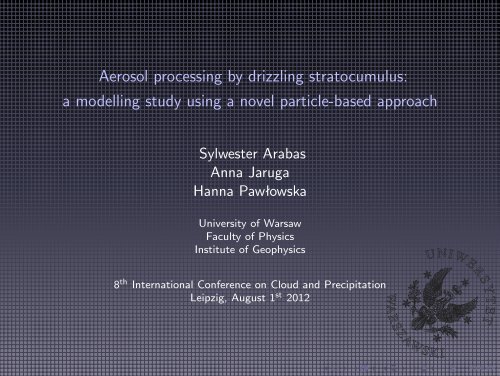
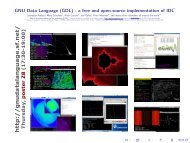

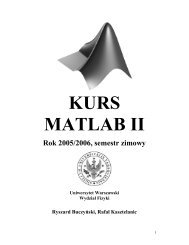
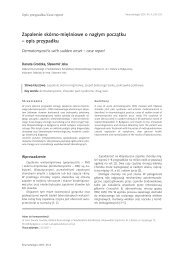
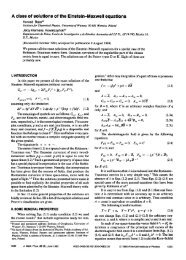
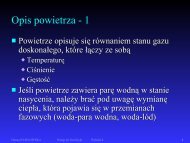
![slajdy [PDF, 0,6 MiB] - Instytut Geofizyki](https://img.yumpu.com/22546539/1/190x143/slajdy-pdf-06-mib-instytut-geofizyki.jpg?quality=85)
